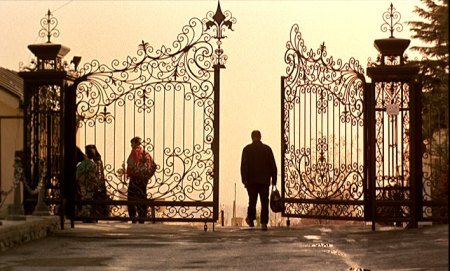The Cinema of Abbas Kiarostami: The Legacy Lives On

Abbas Kiarostami’s death was a shock to the cinema world. He was more than just a filmmaker – he was an artist. His work revolutionized our notion of Iranian Cinema because he focused on authenticity and not popularity. His global success allowed Iran to be seen for its culture and not its politics. In addition, his films were widely known globally across the world and he gained recognition in the festival circuit. His films were not about plot twists nor did it follow any formal structure. Kiarostami just captured the essence of Iranian culture by giving the audience real people to play in his films who have endured struggle, disaster and pain.
His use of the car in almost all his films gave his audience an understanding of the private lives of Iranian people. The car was used as an expression for stories of marriage, depression and personal struggles to unfold. His film, Ten (2002) took place in the city of Tehran, but the audience never gets a chance to city space. Instead, the audience is restricted to the inside of the car in order to focus on the stories of women who are dealing with personal struggles influenced by the state. The car was representation of a home where expression is freely expressed. The space of the car forced the viewer to hear these stories and understand the depths of these stories for its significance.
Kiarostami gave his viewers freedom to become a filmmaker. His simple storylines, his constant use of landscape shots, the peaceful sounds of his music throughout his film gave the audience the freedom to become their own filmmaker by giving them the opportunity to create their own narrative through his films. His simplicity gave viewers the freedom to create the complexity by trying to find their own purpose in relation to his films. He allowed his films to be produced by his audience in order to show that cinema is not about the authority of the filmmaker but rather, the relationship between the filmmaker and its audience. In addition, his simplicity made room for the viewers to express their own questions and their own thoughts. His cinema wasn’t for his own personal growth or understanding of himself instead, it was for his viewers understanding of themselves.
Kiarostami’s cinema revolted against mainstream Hollywood by allowing the audience to make their own conclusions. He never gave his viewers a direct ending to his films because the authenticity of cinema wouldn’t exist. In other words, cinema isn’t about giving the viewer what they want but allowing them to think, reflect and question the purpose of the film. For example, Shirin (2008) was about women going to the movie theater to watch a film. But the only thing the viewer knows about the film that they are watching is the dialogue and the women’s expressions throughout the film. He forces us to watch these women unfold their emotions, which are a direct representation of how it is to fall into the world of cinema. Shirin is about the authority of the viewer, rather than the authority of the filmmaker and Kiarostami ensures that the audience acknowledges it.
Kiarostami will be missed. His passion for the art of cinema was reflected throughout his films which will be inspiration to many aspiring filmmakers. His lack of focusing on conventional techniques such as: use of scripts or famous actors or studio productions gave his cinema more originality. Kiarostami blurred our notions of reality and fiction in order to signify that there is really no true distinction between the two within cinema. His blend of reality and fiction gave the audience an illustration of life by showing that what is real versus what is just an illusion can never be fully defined. He would surprise his viewers with real footage of himself making the film the viewer just finished watching in order to constantly remind the viewer that this is a film, but also a representation of reality. No one still has the real answer behind why Kiarostami would always blur reality and fiction and now, no one will ever know. However, it isn’t about finding the answer to that question because if Kiarostami gave his viewers that answer then, his cinema wouldn’t have its authenticity. His style will never be fully understood, but that is the beauty of cinema because the style belongs to the filmmaker and the narrative and the moving images belong to the viewer.
Abbas Kiarostami will never make a film again and that is okay because his films will always be relevant. Aspiring filmmakers should gain inspiration from his films because his cinema breaks free from the truth. He allows the unity of cinema aesthetics to capture the beauty of what cannot be explained. If a filmmaker constantly focuses on the truth it doesn’t allow for personal growth because there is nothing left to be said about it. But if you capture the simplicity of the unknown, then there is more to be said. This is what Kiarostami established throughout his cinema which enables his stylistic techniques to always be questioned because no one will ever know why. He allowed his creativity to take control, which in turn produced unique cinematography that can never be duplicated. His death will always be a shock to many because the world wasn’t ready to let go of an artist just yet. In the end, Kiarostami will never be forgotten and will live on screen forever.
Here is a clip from his film, Close-Up (1999):
Scene from Taste of Cherry (1997)

Scene from Through The Olive Trees (1994)

Clip From Ten (2002)
What do you think? Leave a comment.











Close-Up in particular is a work of genius, a questioning of the nature of identity and celebrity, and a poignant explication of the human need for attention and meaning. Through the Olive Trees is also extraordinary. What a brave and dignified talent. RIP.
Can’t say I’ve seen too many of his films but ‘Where is the friends home’ is one I’ll always recommend.
For anyone interested in Kiarostami’s work, the Koker trilogy’s a good place to start.
“If a filmmaker constantly focuses on the truth it doesn’t allow for personal growth because there is nothing left to be said about it. But if you capture the simplicity of the unknown, then there is more to be said.”
Yes. Certainty is the death of curiosity and therefore “the truth” is much more of a fiction than the uncertainty of the fictional.
With so few resources at his disposal and the state censor constantly breeding down his neck he still managed to put Iranian cinema on the world stage and inspire generations of film makers both in Iran and throughout the world.
Ten is an unequivocal masterpiece and masterclass in creative limitation. Kiarostami’s legacy as an auteur in World Cinema is thoroughly deserved. A wonderful career and inspired artiste. Rest in peace Abbas, your work will endure.
I fell in love with Iranian cinema after watching his films… My favourite was “where’s my friend’s house”… Very original. Liked his other works too… “Certified copy” was also very nice… Great director… RIP
There is no die for such a creative mind and influential artist. As all the great artists of persian culture, he will thrive in minds of all who read or see his work.
Thankfully, his incredible body of work remains for all of us. Condolences to his family, friends, and many fans.
An absolute genius of the art of film making.
A truly great director, ‘the wind will carry us’ is one of my all time favourite films. I’m going to enjoy watching his films again.
I enjoy filmmaking with cultural themes. I am interested in watching some of Kiarostami’s work.
I watched taste of cherry and i had a feeling like i was breathing dust for hours. It was intense. I wish there were more films from around the world and not only art house ones.
Close-Up, absolutely wonderful film. restored my faith in cinema. The film blew my mind and my heart in ways I didn’t even know were possible.
Thank you for the many, many wonderful films you’ve shared with us. It’s hard to think of any other director that achieved such poetic simplicity in his work.
Kiarostami was a unique and wonderful artist. His films come uncannily close to expressing the essence of what it is to be human.
A terrific film-maker – such simple ways of creating complex stories.
Always intended to watch his stuff but never got around to it. I will rectify that now. RIP.
He translated Persian poetry into motion pictures, a master indeed
RIP, I have meant to watch Taste of Cherry for ages.
Thank you for this article, and for introducing me to the works of this artist.
Some of his pictures were good.
Taste of Cherry was an intriguing film in terms of its characterisation, letting audiences truly explore the character.
It’s amazing, I’ve heard so much about Kiarostami throughout the years, but found myself weirdly avoiding his work. I started really getting into his work a few weeks before his passing – starting with “Close-Up” before moving onto “Where is the Friend’s Home”; the latter of which affected me deeply, and stands high as one of my favorite child films with Malle’s “Murmur of the Heart” and Panini’s “The White Balloon”.
Can’t wait to explore deeper and rewatch some of the ones I saw long before I really “understood” the man.
first of all, I should say that I am really thankful because of this great article. it is as easy as Kiarostami’s films and impressive. He is alive long as his films are being watched by the audiences all around the world. Iranian people take a great deal of pride in him always and forever.
Commitment and being true to your craft requires one to be brave enough to defy the confines of popularity. Truly inspired by this piece.
The death of Kiarostami hit me like a ton of bricks. Shortly after his passing, I read a quote of brilliance that stated by Jean-Luc Godard, “Film begins with DW Griffith and ends with Abbas Kiarostami”. Interestingly, Godard mentioned this during 2005, or 11 years prior of his passing. It is evident that the mentioned was true then, and true to me today. Kiarostami emerged as a filmmaker during a time in Iran where the art he produced was highly subjected and monitored by the Iranian government. During the latter part of his career after establishing a name for himself globally within Iran, Kiarostami broke into filmmaking in Europe and Japan. His time in Iran shined during the Koker Trilogy where he painted an immaculate picture of the people of Iran and the heavy-hearted people he encountered. Many of his films, of course Close-Up being the most obvious, displayed non-actors performing realistic presentations of their lives and practicality. Taste of Cherry is a favorite of mine for the almost real-time aspect of the pacing, very blatant humility, and desperation as the film comes to a close. Kiarostami created a brilliant array of films with convoluted and dense atmospheres with Certified Copy and Like Someone in Love. His talent was evident as no matter where he went, what the subject matter contained, or who his audience was—his brilliant take on atmosphere was always radiant. I never had the pleasure to see any of his films in theatres, but I have wrestled online with trying to find subtitles for some of his films, namely Where is My Friend’s Home, in languages I can understand. Some of his films are gems hidden away, and others are easy to access and watched by many. I hope every film lover can have the time to watch his entire filmography as I have, because it will be nothing short of a cathartic.
Where is the Friend’s Home is such a wonderful depiction of loyalty and the heroics of the ordinary.